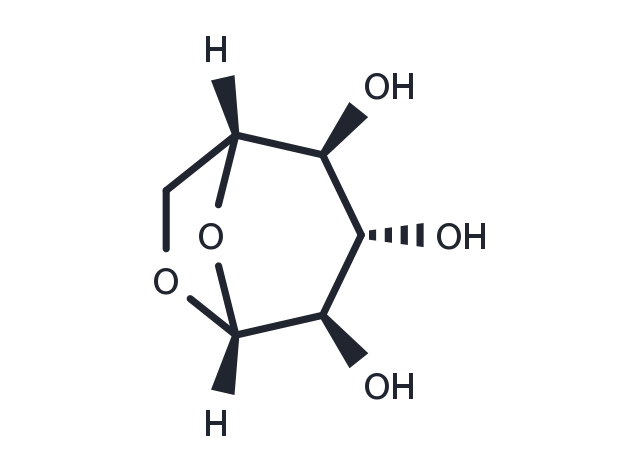Powder: -20°C for 3 years | In solvent: -80°C for 1 year


Levoglucosan (1,6-anhydro-b-D-Glucose) is an anhydrohexose that is the 1,6-anhydro-derivative of beta-D-glucopyranose. It is formed from the pyrolysis of carbohydrates, such as starch and cellulose. Levoglucosan can also be utilized in the synthesis of chiral polymers such as unhydrolysable glucose polymers. Levoglucosan is also produced via caramelization of sugar. Consumption of caramel or caramel-containing sweets can lead to a short-term 5X increase in urinary levels of levoglucosan (from 20 uM/mM creatinine to 100 uM/mM creatinine).

| Pack Size | Availability | Price/USD | Quantity |
|---|---|---|---|
| 500 mg | In stock | $ 55.00 | |
| 1 mL * 10 mM (in DMSO) | In stock | $ 43.00 |



| Description | Levoglucosan (1,6-anhydro-b-D-Glucose) is an anhydrohexose that is the 1,6-anhydro-derivative of beta-D-glucopyranose. It is formed from the pyrolysis of carbohydrates, such as starch and cellulose. Levoglucosan can also be utilized in the synthesis of chiral polymers such as unhydrolysable glucose polymers. Levoglucosan is also produced via caramelization of sugar. Consumption of caramel or caramel-containing sweets can lead to a short-term 5X increase in urinary levels of levoglucosan (from 20 uM/mM creatinine to 100 uM/mM creatinine). |
| Synonyms | 1,6-anhydro-b-D-Glucose |
| Molecular Weight | 162.14 |
| Formula | C6H10O5 |
| CAS No. | 498-07-7 |
Powder: -20°C for 3 years | In solvent: -80°C for 1 year
DMSO: 55 mg/mL (339.21 mM)
You can also refer to dose conversion for different animals. More
bottom
Please see Inhibitor Handling Instructions for more frequently ask questions. Topics include: how to prepare stock solutions, how to store products, and cautions on cell-based assays & animal experiments, etc.
Levoglucosan 498-07-7 Metabolism Others Endogenous Metabolite inhibit 1,6-anhydro-b-D-Glucose Inhibitor inhibitor
